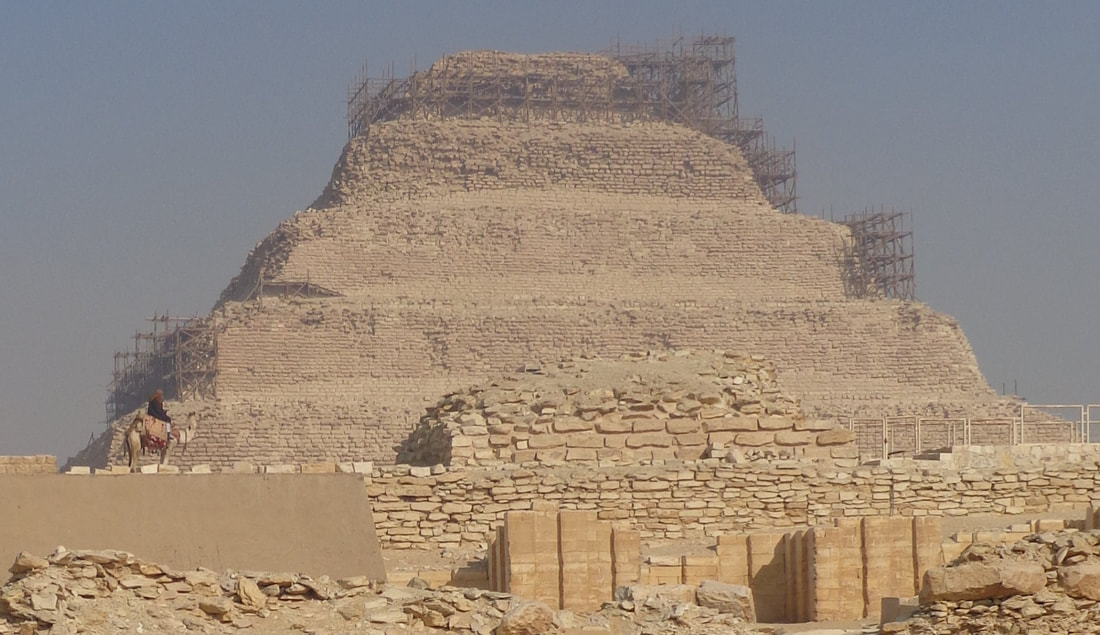|
Read: Exodus 46 (www.biblestudytools.com/nrs/exodus/46.html)
Sing: Day Is Dying in the West, UMH 687 Saqqara is one section of the great necropolis of Memphis which stretches for nearly twenty miles along the Nile. Saqqara is best known for the Step Pyramid of Djoser, the oldest known of Egypt’s 97 pyramids. There are tombs from the 1st Dynasty through the New Kingdom. It is also known for the famous “Pyramid Texts,” spells written to help the king ascend to the heavens and descend again, which reveal the relationship of the king to the gods. Saqqara is also famous for its private Old Kingdom tombs which contain beautiful and revealing scenes in their decorations. During the New Kingdom Memphis took second place to Thebes as Egypt’s capital. Yet even with the government established at Thebes, officials who ruled Upper Egypt lived in Memphis and were buried at Saqqara. The Pyramid of Teti The small hill in the main Saqqara pyramid field with a panoramic view of the whole necropolis is actually the pyramid of Teti, the first ruler of Egypt's 6th Dynasty. It is called "The Place of Teti Endure,” though this pyramid has not endured very well. This pyramid was originally 175 feet tall and had a base of 262 feet square. We were all a little leery of going inside/under this pyramid. The outside looks completely degraded but the corridor leading down to the burial chambers was in excellent condition as were the interior chambers themselves. The Pyramid Texts were everywhere. Hieroglyphs covered all of the walls and on the outside and inside of the sarcophagus. They were beautifully carved and I was impressed with how neatly they were arranged. Djoser’s Pyramid – The Step Pyramid Although the 3rd Dynasty actually began with the pharaoh Sanakht, of whom little is known despite a reign of eighteen years, the real founder is considered to be Djoser. Perhaps only in the case of Abu Simbel and Ramses II has a pharaoh been so closely identified with his architectural monument as is Djoser with Saqqara. The majestic Step Pyramid of Djoser, at the center of the funerary complex of Saqqara, is the oldest structure in the world entirely built of stone and the oldest pyramid yet found in Egypt. Originally it was constructed in the form of a normal mastaba. The mastaba (Arabic for “bench” or “shelf”) was the tomb of nobility and court dignitaries, rectangular in shape with slightly inward leaning walls. A second mastaba was added on top of the first, then a third and several more until a pyramid of six gradually diminishing layers existed. As it stands today, the pyramid is 203 feet in height and the base measures 358 by 410 feet. The burial chamber of the pharaoh was located almost at the center of the pyramid, at the bottom of a large vertical shaft 92 feet deep. From here a labyrinth of rooms, corridors, chambers, and passageways protecting the eternal rest of the sovereign spreads outwards over a length of more than three miles. The Mastaba of Idut Discovered in 1927 by the English archeologist Cecil Firth, this tomb was actually built for a vizier who lived at the time of pharaoh Unas at the end of the 5th Dynasty. At the time of the 6th Dynasty, princess Seshseshet, better known as Idut, took over the burial chambers and entirely altered the original decorations. For me, it was much more interesting to see the carved reliefs of this mastaba where they belong instead of in a museum. I am so grateful that we are allowed to enter these places and see these wonderful works of art that are over four thousand years old! As with the hieroglyphs of Teti’s Pyramid, I was very impressed with how well these engravings were planned and executed. I have seen on the History Channel how they would have many different people work on these carvings: first someone would develop a plan of what they wanted on the walls; then they would sketch what they wanted on the flat wall; rough carving would then be done followed by the finish carvers and then the painters. It is simply amazing to me that some of that paint is still on these walls today. Though you will not find the Mastaba of Idut on any list of major tourist sites in Egypt, I highly recommend it for your viewing pleasure.
0 Comments
Leave a Reply. |
AuthorIn matters of faith, we at First United Methodist Church, Sealy put primary reliance on the Bible. In scripture, we understand that we are all God’s children; therefore, we will be a church that cares for the needs of our church and local community through prayer, deeds, inspiration, and love in the spirit of Christ. Archives
July 2020
Categories |
Location |
Our MissionCaring for the needs of our church and community through prayer, deeds, inspiration and love in the Spirit of Christ.
Sunday Worship: 10 am Adult & Children & Youth Sunday School 9 am First Kids Mother's Day Out (Tuesday & Thursday; 8am to 2pm; Ages 1-3) Rev Pat Bell, Pastor First United Methodist Church Sealy
200 Atchison Street Sealy, Texas 77474 979.885.2223 |
Contact Us |

 RSS Feed
RSS Feed